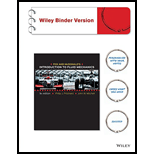
Concept explainers
A barometer accidentally contains 6.5 inches of water on top of the mercury column (so there is also water vapor instead of a vacuum at the top of the barometer). On a day when the temperature is 70°F, the mercury column height is 28.35 inches (corrected for thermal expansion). Determine the barometric pressure in psia. If the ambient temperature increased to 85°F and the barometric pressure did not change, would the mercury column be longer, be shorter, or remain the same length? Justify your answer.
Want to see the full answer?
Check out a sample textbook solution
Chapter 3 Solutions
Fox And Mcdonald's Introduction To Fluid Mechanics
Additional Engineering Textbook Solutions
Web Development and Design Foundations with HTML5 (8th Edition)
Starting Out with Python (4th Edition)
Starting Out with C++ from Control Structures to Objects (9th Edition)
Introduction To Programming Using Visual Basic (11th Edition)
Database Concepts (8th Edition)
Degarmo's Materials And Processes In Manufacturing
- (B) A ductile solid rod, of initial area (25mm) and initial gauge length (8cm), show this tabular data during simple tension process Tensile load in (N) Elongation (mm) 4220.0310 17.7122 4317.3340 33.5254 4225.6478 45.465 Determine the Ludwik model coefficients of this rod numerically. (12.5M) 3957.9528 67.6031arrow_forward### Fluid-Mechanical Circuits Develop the circuit of a drill in the FluidSim, observing the following requirements: 1. The design and assembly of the Hydraulic Circuit drive (clamping and working), with the following characteristics: a. Sequential operation, put pressure, for the advance and return of the cylinders (according to the proper operation for the device) controlled by a directional 4x3 electric drive way; 2. The circuit must provide for different speed ranges for drilling work in order to allow different materials to be processed. Note: Set the safety valve to 55 bar. *The drill is attached in a figurearrow_forwardSolve the following question by hand and without the use of AI. Thank You!arrow_forward
- the answers you provided is very blury to this homework equation can you resendarrow_forwardQ100 The following data refers to a test on a single-cylinder four-stroke oil engine Cylinder bore 220 mm; stroke 360 mm; area of indicator diagram 360mm ²; length of diagram 40mm; indicator spring rating = 1.25 mm/bar; Speed 300 rev/min brake load 441.3 N at 0.9m radius; fuel consumption 3.8 Kg/hr; Calorific value of fuel 43124 kj/kg; Cooling water flow 3.8kg/hr; rise in temperature of cooling water 48K; and specific heat capacity of water 4.1868 kj lkg. k. god valamily Calculate: @the mechanical efficiency the indicated thermal efficiency lo The heat balance sheet expressed as kj/min andas percentage of the heat supplied to the engine.arrow_forwardQ In a test on a two.. strok, heavy oil, marine engine, the following observations were made: Oil consumption, 4.05 kg/h; Calorific value of oil, 43000kj/kg; het brake load 579N; Mean brake diameter, 1m; mean effective pressure 275 kN/m²; cylinder diameter 0.20m; stroke, 0.250m; speed, 360 rpm. Calculate the mechanical efficiency the indicated thermal efficiency Y The brake thermal efficiency and the quantity of jacket water required per مسموح به امتصت minute if 30% of the energy supplied by the fuel is absorbed by this water. Permissible rise in temperature is 20k and specific heat capacity of water-4.1868 kj Answers [84.2%, 26-8%, 22.6%, 8.33 kg/min] kg.k عماد داود عبودarrow_forward
- Q78 A four cylinder, four-stroke Petrol engine has a compression ratio of 6 to 1. A test on this engine gave the following results; Net brake load = 20 kg, effective brake arm = 0.5 m, indicated mep=6*105 N/m², engine speed 2400 rpm, fuel consumption = 10 kg/h, Calorific value of the fuel = 44000kj/kg, Cylinder bore 86 mm, engine stroke-100mm. ข่าวล Calculate: the mechanical efficiency, ⑥the brake thermal efficiency the relative efficiency assuming the engine works on the Constant volume cycle and that 8-1.4 forair ⑧The brake mean effective pressure. Answers 1 88.4%, 48/5-35 × 105 N/m² 1 و وarrow_forwardHom Work عماد داود عبور (35) Q18 The Fiat car has a four strok engine of 1089 C.C capacity.It develops maximum power 32kw at 5000 r.p.m. The volumetric efficiency at this speed is 75% and the air-fuel ratio 13:1, At peak power the theoretical air speed at the choke is 120 m/sec. The coefficient of discharge for the venturi is 0.85 and that of the main petrol jet is 0.66. An allowance should be made for the emulsion tube, the diameter of which can be taken as (1/2.5) of the choke diameter. the Petrol surface is 6 mm blow the choke at this engine condition. Calculate the size of a suitable choke (D) and main jet (d).The specific gravity of Petrol is 0.75 andthe Latmospheric pressure 1.03 bar and temperature 27°c. [D=23.2mm,d=1.296mm]arrow_forwardQ8: A test carried out on a single cylinder, two. Stroke oil engine gave the following data: Cylinder bore = 200 mm, stroke 250mm, engine speed = 300 rpm, net brake torque 500N.m indicated mean effective Pressure = 4.9*105 N/m², fuel consumption = 5kg/min, Cooling water. rate of flow = 0.0666 kg/sec, temperature rise of cooling water-55k, specific heat capacity of water =4.1868 kj/kg.k. calculate the mechanical efficiency, the specific fuel consumption, and draw up an energy balance in kw. Answers [@ 81.6, 0.318 kg/kW.hr, © Qtotal = 61.1kw,- Qb.p = 15.7 Kw₂ & Cooling water = 15.35kw,Q Exhaust = 30.05 kw]arrow_forward
 Elements Of ElectromagneticsMechanical EngineeringISBN:9780190698614Author:Sadiku, Matthew N. O.Publisher:Oxford University Press
Elements Of ElectromagneticsMechanical EngineeringISBN:9780190698614Author:Sadiku, Matthew N. O.Publisher:Oxford University Press Mechanics of Materials (10th Edition)Mechanical EngineeringISBN:9780134319650Author:Russell C. HibbelerPublisher:PEARSON
Mechanics of Materials (10th Edition)Mechanical EngineeringISBN:9780134319650Author:Russell C. HibbelerPublisher:PEARSON Thermodynamics: An Engineering ApproachMechanical EngineeringISBN:9781259822674Author:Yunus A. Cengel Dr., Michael A. BolesPublisher:McGraw-Hill Education
Thermodynamics: An Engineering ApproachMechanical EngineeringISBN:9781259822674Author:Yunus A. Cengel Dr., Michael A. BolesPublisher:McGraw-Hill Education Control Systems EngineeringMechanical EngineeringISBN:9781118170519Author:Norman S. NisePublisher:WILEY
Control Systems EngineeringMechanical EngineeringISBN:9781118170519Author:Norman S. NisePublisher:WILEY Mechanics of Materials (MindTap Course List)Mechanical EngineeringISBN:9781337093347Author:Barry J. Goodno, James M. GerePublisher:Cengage Learning
Mechanics of Materials (MindTap Course List)Mechanical EngineeringISBN:9781337093347Author:Barry J. Goodno, James M. GerePublisher:Cengage Learning Engineering Mechanics: StaticsMechanical EngineeringISBN:9781118807330Author:James L. Meriam, L. G. Kraige, J. N. BoltonPublisher:WILEY
Engineering Mechanics: StaticsMechanical EngineeringISBN:9781118807330Author:James L. Meriam, L. G. Kraige, J. N. BoltonPublisher:WILEY





